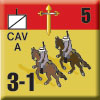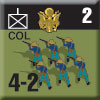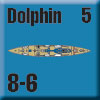| To Hell With Spain:
Publisher's Final Look Back
By Mike Bennighof, Ph.D.
April 2015
Sometimes, I come up with pretty good ideas. Really, it’s true. And sometimes I don’t. Infantry Attacks: To Hell With Spain - a full game crammed into the download format - is one of the latter.
 The original assignment I handed out was simple enough: I wanted a downloadable Infantry Attacks module with 10 scenarios and 88 pieces, based on the battle of the Spanish-American War. We had decided, at that point, not to publish “mainstream” titles in the download line, and the land battles of 1898 definitely seemed outside the main stream. The original assignment I handed out was simple enough: I wanted a downloadable Infantry Attacks module with 10 scenarios and 88 pieces, based on the battle of the Spanish-American War. We had decided, at that point, not to publish “mainstream” titles in the download line, and the land battles of 1898 definitely seemed outside the main stream.
Problems came when the original 88 pieces started ballooning well beyond that, eventually coming to a stunning 330. The culprit here was a single scenario and its prequel; the other eight can probably be played with 88 pieces (I haven’t done the math on it). But the one monstrous scenario (in terms of pieces, anyway; there are only two mapboards in play) is San Juan Heights, the one recognizable land battle of the Spanish-American War. How can you have a game about the Spanish-American War without the Charge Up San Juan Hill (actually Kettle Hill), the Rough Riders, Teddy Roosevelt and all that? It couldn’t be chopped out and it couldn’t be cut down (damned U.S. Army and their overwhelming numbers). We’d have to make To Hell With Spain a gigantic download.
 What we had, then, was a download that could never possibly justify in sales the time and energy it had taken to create, even without our having to print anything. And since experience had made it obvious that downloads had a firm price ceiling, To Hell With Spain had way too much bang for the buck. And there’s a lot of bang: as far as I know, this is the only tactical-level treatment of land combat in the Spanish-American War. And it’s a really good game, easily the best product in the old download line as far as play value goes. What we had, then, was a download that could never possibly justify in sales the time and energy it had taken to create, even without our having to print anything. And since experience had made it obvious that downloads had a firm price ceiling, To Hell With Spain had way too much bang for the buck. And there’s a lot of bang: as far as I know, this is the only tactical-level treatment of land combat in the Spanish-American War. And it’s a really good game, easily the best product in the old download line as far as play value goes.
With our current production capabilities, To Hell With Spain would have been a boxed game, almost certainly offered direct-only from Avalanche Press, with a new purpose-made set of maps in place of maps pulled from six different Panzer Grenadier games. But this is now and that was then; we could only make such games in (relatively) large numbers back in 2010, and printing a boxed To Hell With Spain would have cost us well over $20,000, money we surely did not have. So even though it was greatly oversized for a download, we shoe-horned it into the format and a download it became.
 Now that we have better means of production at hand, we’re giving the Gold Club a last chance to pick up a printed copy, with a nice set of 330 scorchless, sootless laser-cut playing pieces. This is a special item we won’t be keeping in stock. Now that we have better means of production at hand, we’re giving the Gold Club a last chance to pick up a printed copy, with a nice set of 330 scorchless, sootless laser-cut playing pieces. This is a special item we won’t be keeping in stock.
So what do you get in this (relatively) gigantic package?
The most obvious item in the special edition is the set of playing pieces: 330 of them, laser-cut and smooth (no dog-ears or depressions from getting smashed by a die), without scorch marks or soot. Best of all, having these fine pieces removes the greatest weakness of To Hell With Spain as a product: you don’t have to cut-and-paste 330 game pieces - 660 faces - yourself. It’s not only already done for you, it’s done really, really well.
 The pieces represent the forces of Spain and the United States, plus Cuban rebels. The Spanish regular army includes local militia and regular forces raised in Cuba and Puerto Rico, though most of them are from Spanish regiments raised in Spain. They are outnumbered in most scenarios, vastly so in some of them, but field higher-quality infantry than the Americans and much better artillery. The pieces represent the forces of Spain and the United States, plus Cuban rebels. The Spanish regular army includes local militia and regular forces raised in Cuba and Puerto Rico, though most of them are from Spanish regiments raised in Spain. They are outnumbered in most scenarios, vastly so in some of them, but field higher-quality infantry than the Americans and much better artillery.
The Americans, on the other hand, bring a whole array of forces. There are U.S. Army regulars, including infantry and a great deal of dismounted cavalry. Plus some artillery and a Gatling gun. There are U.S. Army “colored” regulars, black troops with infantry and dismounted cavalry but no support weapons or leaders of their own, though they often have better morale than the white troops. And there are U.S. Volunteers, with infantry and dismounted cavalry that’s usually less capable than those of the regulars, but artillery that’s at least as good. There’s also a small battalion of U.S. Marines, with some of the few machine guns in the game, and a single company of black Volunteer infantry. And a gunboat.
 Back-dating the Infantry Attacks game system a generation earlier to the Spanish-American War requires a few special rules, but it’s not too burdensome. There are no planned fire missions for artillery, which actually makes the game somewhat quicker to play than World War One scenarios. Many units are still firing black-powder cartridges, which sets off massive clouds of smoke, and in game terms that makes it harder for them to see the enemy but easier for the enemy to see them. There are some other situation-specific rules as well, like barbed wire, American racial segregation and some special terrain rules to make all those maps from other games stand in for Cuba and Puerto Rico. Back-dating the Infantry Attacks game system a generation earlier to the Spanish-American War requires a few special rules, but it’s not too burdensome. There are no planned fire missions for artillery, which actually makes the game somewhat quicker to play than World War One scenarios. Many units are still firing black-powder cartridges, which sets off massive clouds of smoke, and in game terms that makes it harder for them to see the enemy but easier for the enemy to see them. There are some other situation-specific rules as well, like barbed wire, American racial segregation and some special terrain rules to make all those maps from other games stand in for Cuba and Puerto Rico.
The scenarios take place in Cuba and Puerto Rico, and range from pretty small affairs with a few companies on a side to the massive battles of El Caney and San Juan Heights. This is where the game situations stretch the game system; while the two big scenarios work fine as designed they would probably be a little easier to play with units representing battalions rather than companies. On the dense battlefield the stacks of companies pretty much function as battalions with six steps.
You can read about the scenarios here (Part One) and here (Part Two).
To Hell With Spain was an ambitious project, and a really unusual one. It’s not something I can see us doing again, so once the current promotion is over, that will be the end of the module.
Don’t wait to put To Hell With Spain on your game table, or you'll miss it forever and you will be sad. Join the Gold Club and find out how to get it before it goes away!
Mike Bennighof is president of Avalanche Press and holds a doctorate in history from Emory University. A Fulbright Scholar and award-winning journalist, he has published over 100 books, games and articles on historical subjects.
He lives in Birmingham, Alabama with his wife, three children and his dog, Leopold. Leopold is a good dog.
|
